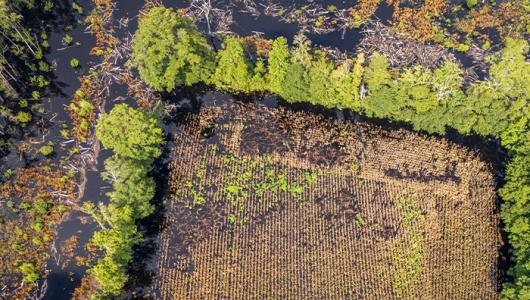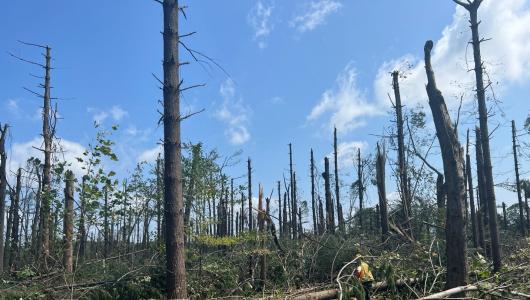This Friday meet the Hightowers, a West Texas farming and ranching family that raises cattle and cotton. Shelly, and her late husband Rickey, were determined to carry on the family’s ranching legacy for their children. The family was named the 2019 Conservation Ranchers of the Year by the Andrews County Soil and Water Conservation District Board for their land improvement efforts.

Building Drought Resilience
Rickey’s father lost his ranch in the 1980s due to drought, hard economic times, and high interest rates. Losing the ranch he grew up on weighed heavily on Rickey’s heart as he watched his father and mentor lose almost everything.
When Rickey and Shelly got the ranch back in 2012, they saw an opportunity to expand their legacy for their children and grandchildren. When the Hightowers were awarded their bid to lease the L7 Ranch from the University of Texas System, the state was in a drought with little cattle forage available. They hoped they hadn’t made a huge mistake. The drought eventually broke, and they were blessed with rain.
Wanting to better manage the ranch, they decided to set up a grazing plan that included a drought plan. To accomplish this, they contacted USDA’s Natural Resources Conservation Service staff to develop a conservation plan.

To help implement the plan, the Hightowers used the Environmental Quality Incentives Program, which provides financial and technical assistance to address natural resource concerns including drought mitigation.
To balance available forage and livestock demand, they began repairing and improving water resources, including replacing windmills with solar pumps, installing new water wells, water storage, troughs, and livestock pipelines to increase water distribution. The new conservation plan also called for cross fencing allowing rotational grazing to improve plant communities, soil health, and wildlife habitat. They also implemented brush management practices using chemical control and prescribed grazing.
“Having a plan in place prior to the onset of drought conditions can help producers operate more efficiently and recover quickly from natural disasters,” said Clint Lemay, NRCS district conservationist in Andrews County.

Keeping the Ranch Going
On February 16, 2020, tragedy struck when Rickey passed away unexpectedly. Losing Rickey was difficult, but Shelly is filling his boots with her children stepping in to help.
“Four months before Rickey passed, our youngest son, Ross, came to work with us at the ranch leaving his oil field career which, in hindsight, was a blessing from God,” said Shelly.

Ross had learned about management and the day-to-day operations from Rickey.
"He even brought some things to our attention that Rickey and I hadn’t really thought about,” Shelly said. “I know Rickey is looking down at us proud with that big smile knowing we are keeping things going in the correct direction. We have big boots to fill, and we are proud to step in them and saddle up to keep on ranching.”
Both Rickey and Shelly gave back to the agriculture community by serving in leadership roles. Shelly currently serves on the Mustang Soil and Water Conservation District Board and Rickey was on the FSA County Committee.
Drought Assistance
Even with a plan to better manage drought conditions, losses are unavoidable. The Hightowers used the Livestock Forage Disaster Program through the Farm Service Agency to help provide forage to livestock during qualifying droughts. LFP provides payments for grazing losses due to a qualifying drought on native or improved pastureland with permanent vegetative cover.
The Hightowers used crop insurance to further manage their risk. Previously, they purchased federal crop insurance administered by the Risk Management Agency to insure cotton and grain sorghum crops. They also purchased Pasture, Rangeland, Forage, which helps protect an operation from forage loss risks due to a lack of precipitation.

Additionally, the Hightowers use FSA’s Noninsured Crop Disaster Assistance Program to protect noninsurable grazing crops against natural disasters that result in lower yields or crops losses.
Producers impacted by drought can get relief through emergency haying and grazing of Conservation Reserve Program acres, when authorized. Assistance is also available for the additional cost of transporting water to livestock during an eligible drought through the Emergency Assistance for Livestock, Honeybees and Farm-Raised Fish Program.
The U.S. Drought Monitor
Producers facing drought conditions can use the U.S. Drought Monitor for making important management decisions. The Monitor is an online, weekly map showing the drought location, extent, and severity across the nation. It categorizes areas as being in one of six levels of drought.
In some cases, it may help a producer make specific decisions, such as reducing the stocking rate because forage is not growing. For others, it may provide a big-picture snapshot of broader environmental conditions. To learn more, read our Ask the Expert blog with climatologist Brian Fuchs.

More Information
Each Friday visit local farms, ranches, forests and resource areas through our Fridays on the Farm stories. Meet farmers, producers and landowners who are working to improve their operations with USDA programs.
USDA offers a variety of risk management, disaster assistance, loan, and conservation programs to help agricultural producers in the United States weather ups and downs in the market and recover from natural disasters as well as invest in improvements to their operations. Learn about additional programs.
For more information about USDA programs and services, contact your local USDA service center.
Donnie Lunsford is a public affairs specialist for NRCS in Texas.


